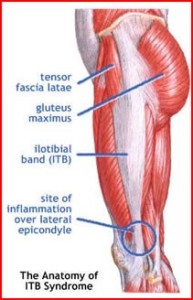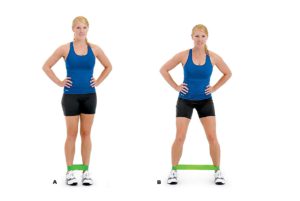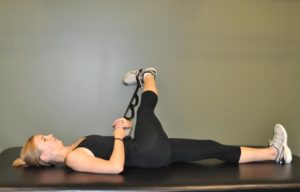

Gabriella DeLorenze
THE “IT” BAND
- ,
- , Anatomy, Education, Hip Pain, Knee Pain, Lower Body, Pain, Pain Relief, Strength, Stretch, Uncategorized
What is the Iliotibial (IT) Band and why does everyone keep talking about it?
Put your hands on your hips and with your fingertips feel the edge of your pelvis bone, or in anatomical terms, your anterior iliac crest. The IT Band attaches here, via your tensor fascia latae muscle (TFL). It then runs along the length of your thigh and inserts on the top of the outside of your shinbone (See Diagram). The IT Band is a thick band of connective tissue responsible for the connection hip muscles to the thigh and the tibia and is an active part in keeping you mobile. However, most people throughout their  lifetime will experience IT Band Syndrome at one point or another in which they sense pain ranging from mild to severe popping up in various locations within hip, knee or even ankle.
lifetime will experience IT Band Syndrome at one point or another in which they sense pain ranging from mild to severe popping up in various locations within hip, knee or even ankle.
How can an IT Band Syndrome form?
The Tensor Fascia Latae, the muscle that connects the IT Band to the hip, along with the gluteus medius muscle, located right below the gluteus maximus in the diagram above, both support the hip and leg in the movement known as abduction. Abduction occurs as we carry our leg away from the mid line of our body (picture your leg opening like a hinge from the waist out while the rest of your body stays centered and facing forward). If this motion of abduction is weak, it can cause an increase in activation of the TFL which is also in charge of hip flexion (picture standing on one leg with the other leg marching up). An in balance of the TFL and gluteus medius cause your knee to cave in, as well as, cause a strain in the IT Band causing it to get taut. These indications can manifest into symptoms such as hip pain, knee pain and even lower back/ sacroiliac (SI) joint pain.
Who is affected by IT Band problems?
To be honest, everyone. Females as they have naturally occurring wider hips (to evolutionarily aid in child birth) often have weak abduction muscles, causing strain in the IT Band. Runners and walkers may also be affected by IT Band related issues due to the overuse nature of both of the sports. People with flat feet should also take precautionary measures as their gait often creates a strain in the IT Band due to the change in angle between your ankle, knee and hip. IT Band Syndrome is caused normally by overuse so we must take care in building up the muscles around it while also working to strengthen, stretch, and support these areas.
Due to the makeup of the IT Band it does not stretch very well especially in comparison to how easily it tightens up. However, by consistent stretching and strengthening of the abductors of your hip, we can alleviate IT Band related issues and prevent further injury.
So, how can we strengthen these areas?
Strengthening can consist of clam shells (see my last Instagram post @soultosolewellness) and lateral band walking to name a few.
To lateral band walk, we want to turn sideways facing one wall, and with our bands wrapped around both ankles (as shown above) walk for ten yards and while facing the same way return back to where you started as to make sure we strengthen both sides. We want to do this motion walking with straight legs (quads tight), as well as with the knees bent. Be mindful to always have both sets of toes facing perpendicular to the direction you’re walking). If your bands are light, try using one band just above your knees and one at your ankles. By the end of 2 or 3 sets, I’m sure you will not be smiling as our example in the diagram above!
As far as stretching goes, my favorite release technique is using a foam roller.
If it feels okay, lift both legs over the foam roller. If this position is too much, put more weight onto your hands and take the  weight off of your hip. If it feels like your muscles are being ripped, congratulations! You’re doing it right! The “hurts so good” phrase is definitely appropriate for foam rolling! But do not be discouraged, this stretching exercise does wonders in alleviating some of the symptoms of IT Band Syndromes. With your legs on the foam, roll up and down from your hip all the way to just past your knee (where the IT Band runs) If you find a spot that especially hurts, try pausing over that spot for 30 seconds before resuming rolling. Try for just 3 minutes on each side.
weight off of your hip. If it feels like your muscles are being ripped, congratulations! You’re doing it right! The “hurts so good” phrase is definitely appropriate for foam rolling! But do not be discouraged, this stretching exercise does wonders in alleviating some of the symptoms of IT Band Syndromes. With your legs on the foam, roll up and down from your hip all the way to just past your knee (where the IT Band runs) If you find a spot that especially hurts, try pausing over that spot for 30 seconds before resuming rolling. Try for just 3 minutes on each side.
If you believe your symptoms to be stemming from flat feet, we have seen much success in inserting orthotic insoles within your shoes. Coupling this with the strengthening and stretching techniques mentioned above, we have seen many patients overcome their symptoms. Orthotics will put your body in a position to alleviate some of the strain in your IT Band and correct posture and joint mechanics to create a healthier gait.
Another stretch I love is similar to a supine twist (Supta Jaṭhara Parivartānāsana) where you’re laying on your back with one knee bent and twisting the leg across your body; however, instead of bringing the knee across your body, pull your knee just to your opposite shoulder, squeezing up. Allow some full deep breaths in this position as the muscle allows itself to release. Feel free to play around with this stretch allowing your leg to come out of the bend and into a straight position if your body allows!
of bringing the knee across your body, pull your knee just to your opposite shoulder, squeezing up. Allow some full deep breaths in this position as the muscle allows itself to release. Feel free to play around with this stretch allowing your leg to come out of the bend and into a straight position if your body allows!
Please keep in mind that the TFL also flexes the hip so it is important to stretch your hip flexors and hamstrings. Since the IT Band crosses your knee joint, it is important to stretch your quadriceps, hamstrings and calf muscles as well! Remember, your body works together, so it is important to strengthen and stretch all areas working to create cohesive and fluid movement.

